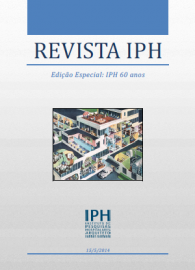Publications IPH Magazine Special: 60th Anniversary Hospital Engineering and Maintenance: Committing To Maintaining Lives

- EDITORIAL
- Future Trends in Teaching and Research Hospital Design
- Jarbas Karman and the Hospital Architecture
- Surgical Centers: An Approach
- Acoustic Comfort In Healthcare Environments: Music, Landscape And Cladding Material As Humanizing Solutions
- Hospital Engineering and Maintenance: Committing To Maintaining Lives
- Communication and Leadership in Health Institutions
- The Relationship Between Professionals And Patients In The Health Sector - Tendencies And Perspectives
Hospital Engineering and Maintenance: Committing To Maintaining Lives
Fumio Araki
Introduction
We congratulate IPH - Instituto de Pesquisas Hospitalares Arquiteto Jarbas Karman on their 60th anniversary.
We would like to express our enormous gratitude to late dr. Jarbas Karman for his invaluable contribution to the area of Health, not only related to the administrative sector, but also the technical and scientific areas.
Some of this unforgettable master's teachings should be re-visited , since he was a great expert and a tireless researcher, having always been extremely dedicated to the cause of safety, concerning patients, doctors and employees in health institutions.
We often had the great privilege of visiting dr. Karman's office on Piracuama Street - Perdizes, in São Paulo, and of interacting with him, his board of directors and his team. And that office was doubtlessly a true laboratory and a center of hospital technical research.
Hospital Engineering and Maintenance: Committing to maintaining lives
Below are some of the concerns and suggestions shared by Engineer and Architect Dr. Jarbas Karman which keep true and active in our daily routine:
- A hospital is a work in progress. When construction work is finished, it already needs refurbishing. A modern hospital must be a constant construction site and managers must always be in search of structural change and improvement.
- Besides the medical, architectural, engineering and management mistakes certainly happening in hospitals, and more often than is disclosed, there are a surprising number of maintenance and safety mistakes.
- All is connected in a hospital. There is an organic interdependence. If there were not so many "human mistakes", and if there were more of a sense of responsibility and more knowledge and experience, many events, such as hospital infection, idleness and waste, accidents and deaths, could be avoided.
- In Brazil Corrective Maintenance prevails although it is costlier and rather troublesome. Preventive Maintenance, prevailing in developed countries, can prevent incidents, accidents and even deaths. Predictive Maintenance precedes Preventive and Corrective Maintenance and starts at project phase. That is why it can also be called Anticipatory Maintenance.
- Maintenance is generally viewed by Hospital Administrators as a source of spending, not as a means to generate safety and savings in a hospital.
- Regardless of being third parties or not, the Hospital Maintenance team must be built by gathering trained and qualified professionals, since the smallest mistake can endanger human life.
- Efficient maintenance requires responsibility, discipline and knowledge from all those working at the institution, not only the specific technical team. A serious harmful problem persisting in our hospitals is the misuse of equipment and facilities, which causes great loss and operational and administrative trouble.
- The critical hospital sectors must be provided with resources and procedures to warrant the patients, doctors and employees' physical integrity, as predicted by RDC-50 and ABNT regulations, such as:
- Generator groups and no-breaks, with redundancy and preventive testing scheduled.
- Shock and electrical discharge protection.
- Balanced energy, connected to earth, without oscillations in voltage.
- Adequate finishing for walls, floors and ceilings, which can allow for easy and effective cleaning and asepsis.
- Air quality with minimum filtering necessary, according to the regulation's requirements. There must be a schedule for preventive maintenance of air-conditioning equipment, duct network, filters, and temperature and dampness control, as well as for monitoring of air quality through lab tests that can detect the maximum number of particles, fungi and bacteria allowed per unit of air volume in the room.
- Properly treated cold and hot water supply, adequate for consumption and offering no risk of discontinued provision.
- Fire-protection systems with updated inspection visits by Firefighters. Escape routes properly signaled and a trained and qualified Fire Brigade.
- A contingency plan for water and power shortage, and for fire situations and emergencies in general.
- Updated licenses and permits issued by competent organs granting buildings permission to be used.
- Medicinal gases networks, properly identified according to technical norms, so as to avoid the undue changes that have happened concerning oxygen and medicinal compressed air. The source of medicinal compressed air, as well as its piping, must ensure the purity of the air produced and administered to patients to utmost safety.
- No informally built wings which might imply electric overload on generators, chillers, building structure, etc.
- Outsourcing of the means so that the hospital may concentrate on the ends.
- Design by capable professionals in case of construction and refurbishing; licenses granted by competent organs, protection by hoarding and execution meant to generate the least trouble possible to patients, escorts, doctors and hospital employees. The circulation of construction materials, equipment, as well as debris, must be planned and sorted out in connection with managers´ and nurses´ teams.
- Sustainable strategies and clean technology in the projects, pushing environmental preservation measures.
- Support environments carefully planned in the architectural project, so as to prevent equipment, stretchers, cleaning carts, linen carts, food carts, garbage carts, etc, to get unduly parked in the halls. Dirty or contaminated materials should not pass by elevators and halls in critical hospital sectors.
- Significant participation of Hospital Architecture, Engineering and Maintenance in the control of hospital infection and in the institutional certification process.
Final Recommendations
The market offers qualified and capable professionals and companies in the field of Hospital Architecture, Engineering and Maintenance in several modalities and areas of expertise. It is always convenient to secure a sound investment by hiring the services of specialized professionals and companies, since they have the means to offer and certify quality standards and grant the necessary warranty to hospital buildings and facilities.
We know that cheap may turn into expensive in the long run: most building crumbling, fires caused by electrical problems, constant leaking, equipment malfunctioning due to electrical problems (oscillations in voltage, failure in earth connection, unbalanced phases), problems due to excessive dampness and high room temperature, warm uncomfortable surgery rooms not meeting the basic demands predicted by regulations, all added to several incidents, accidents and technical problems experienced routinely in health institutions are unfortunately the outcome of lack of planning and the negligence of the professionals responsible for those buildings and facilities.
Bibliography
KARMAN, Jarbas. Manual de manutenção hospitalar. São Paulo: Pini, 1994.
KARMAN, Jarbas. Manutenção e segurança hospitalar preditivas. São Paulo: Estação Liberdade, IPH: 2011.
Related Content
Send by e-mail:



